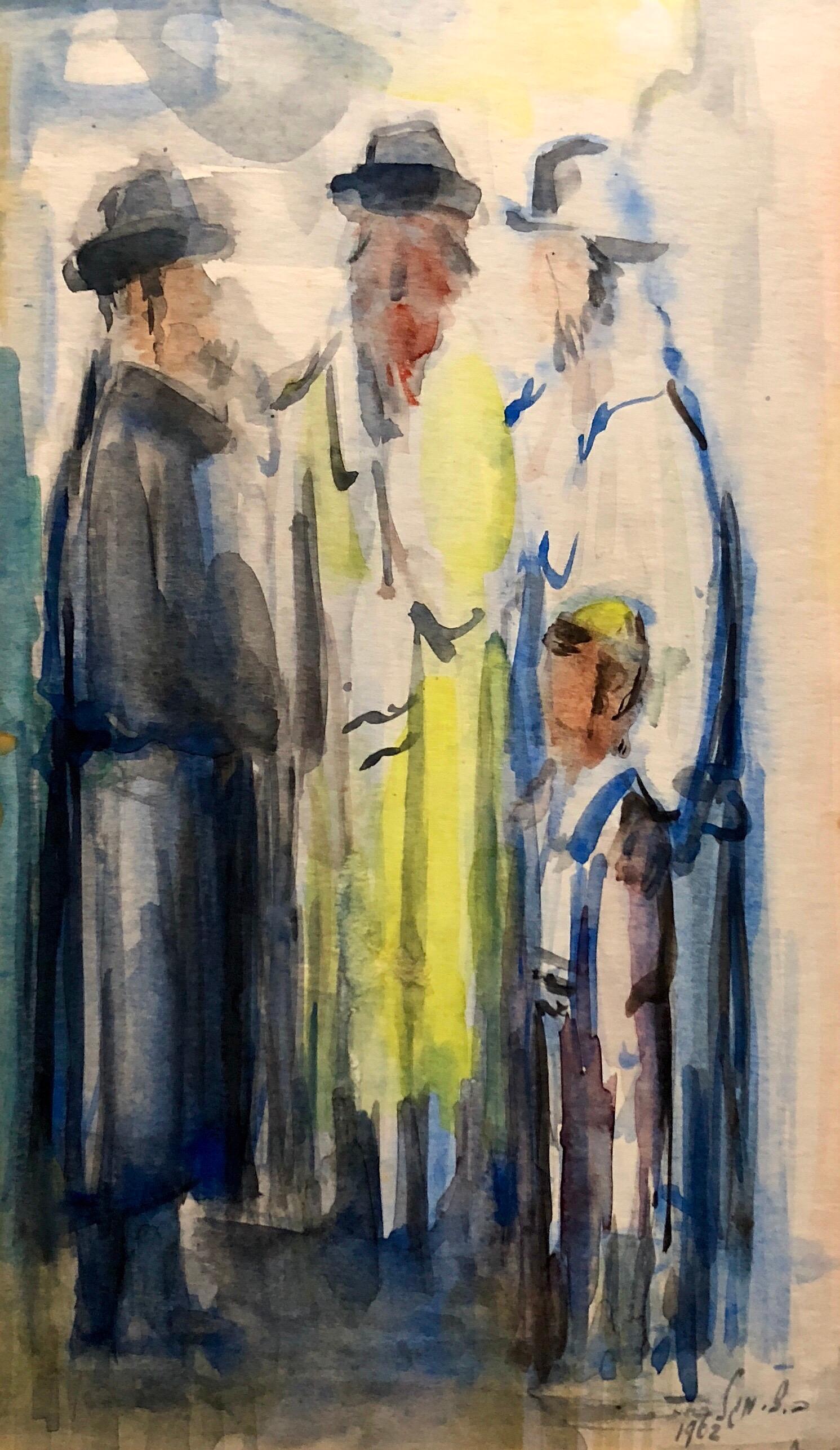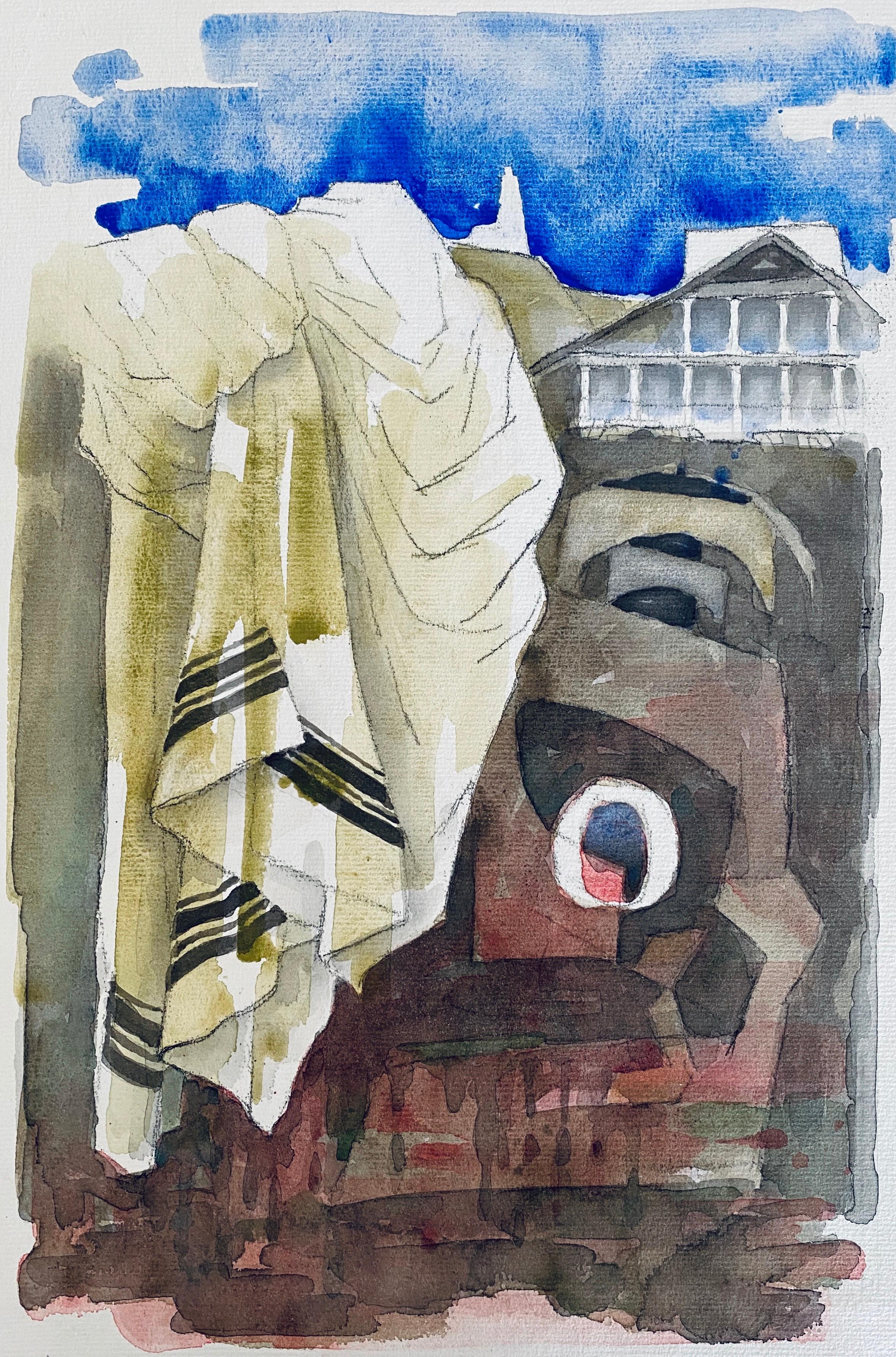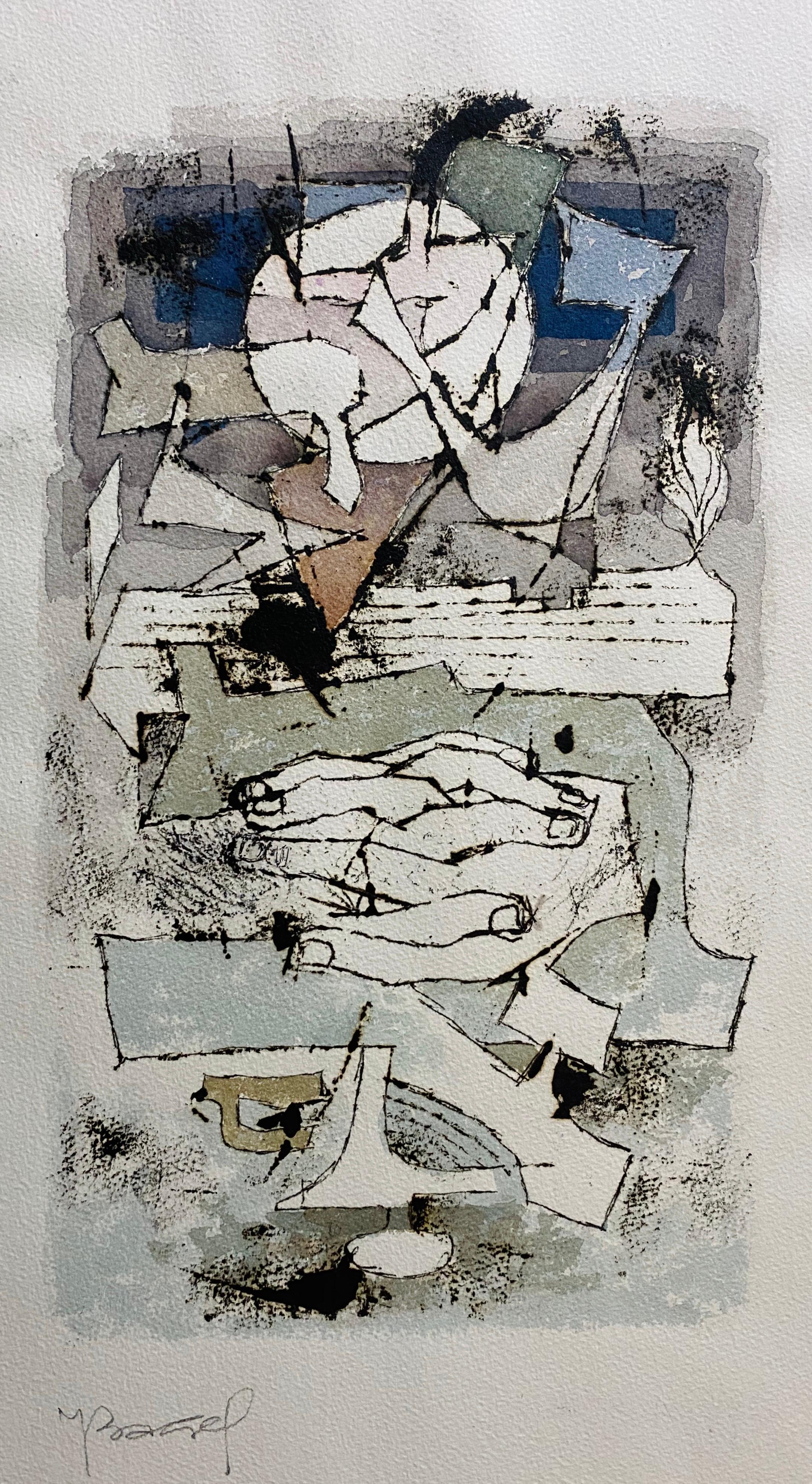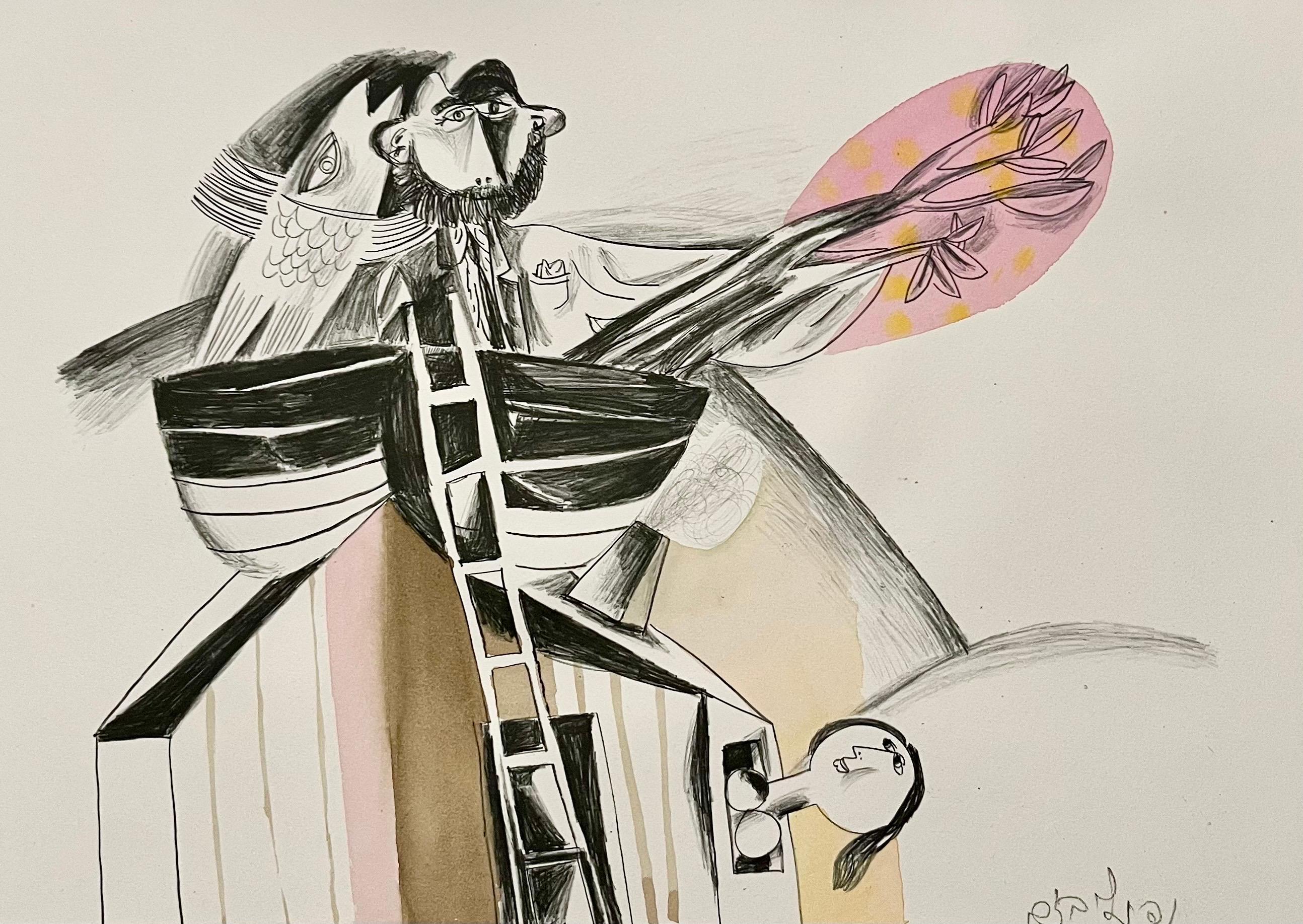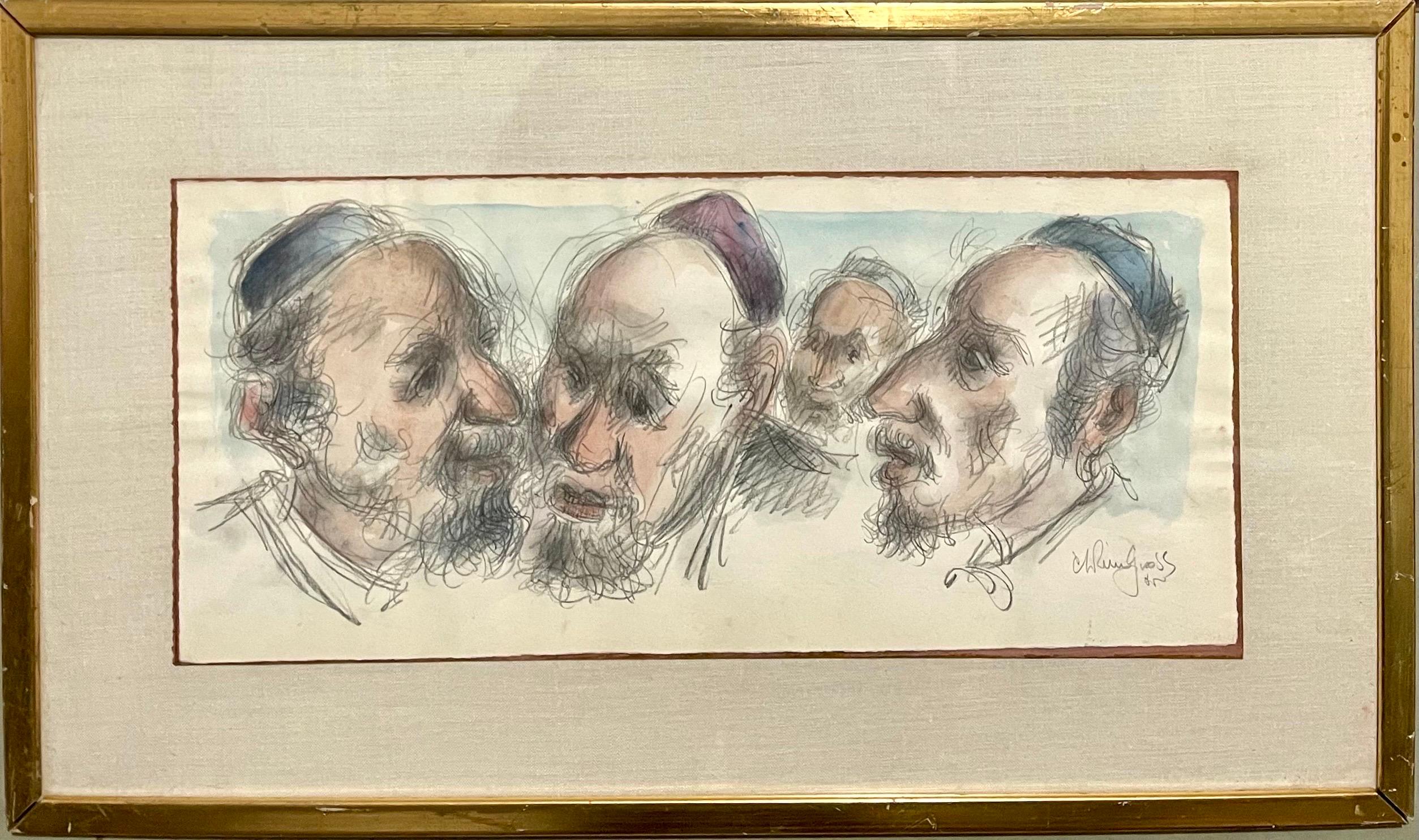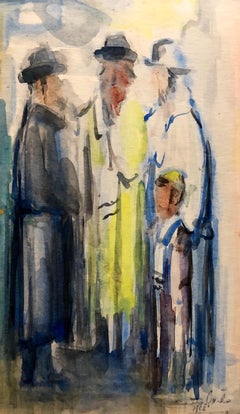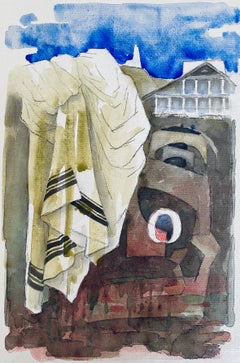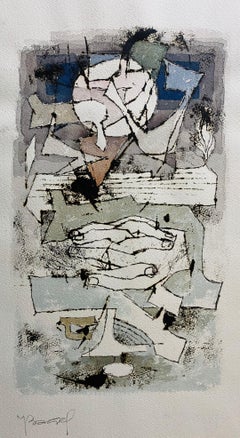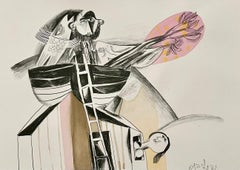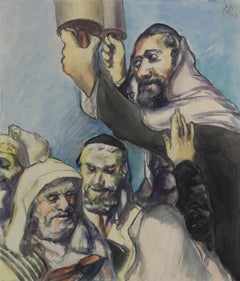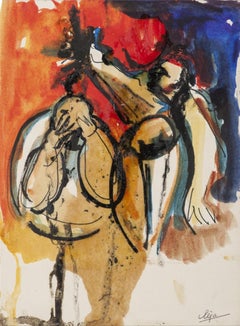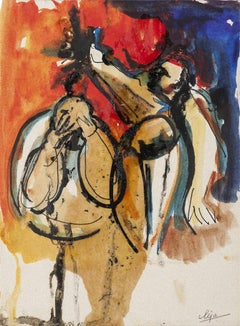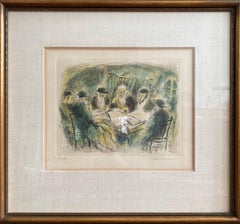Items Similar to Modernist Watercolor Painting Judaica Kiddush Levana Blessing New Moon
Want more images or videos?
Request additional images or videos from the seller
1 of 10
Emanuel Glicenstein RomanoModernist Watercolor Painting Judaica Kiddush Levana Blessing New Moon
$1,800
£1,362.41
€1,568.79
CA$2,560.69
A$2,773.86
CHF 1,460.55
MX$33,668.91
NOK 18,214.88
SEK 17,221.74
DKK 11,711.47
About the Item
Genre: Judaic prayer scene
Subject: Landscape
Medium: watercolor
Surface: Paper
Country: United States
EMANUEL ROMANO
Rome, Italy, b. 1897, d. 1984
Emanuel Glicenstein Romano was born in Rome, September 23, 1897.
His father Henryk Glicenstein was a sculptor and was living in Rome with his wife Helena (born Hirszenberg) when Emanuel was born his father obtained Italian citizenship and adopted the name Enrico. Emanuel was brought up in Italy, Switzerland, Germany, England and Poland.
In 1926 Emanuel and his father sailed for New York. They briefly visited Chicago. Romano's sister, Beatrice, and mother only joined them in New York years later.
Romano changed his name on his arrival to America and some have erroneously speculated that this was to avoid antisemitic anti Jewish discrimination. In truth, as the son of a highly-regarded artist, Romano changed his name to ensure that any success or recognition he would later attain, would be the result of nothing other than his own merit as an artist, and not on account of his father's fame.
In 1936 Romano was worked for the Federal Art Project creating murals. During and immediately after World War II, Romano created a series of allegorical works depicting graphic holocaust images that were held closely by the family until after his passing. One of these works is now on permanent display in the Florida Holocaust Museum in St. Petersburg Florida.
Emanuel's father died in 1942 in a car accident before they could realize their shared dream of visiting Israel.
In 1944 Romano, having completed his degree at the Pennsylvania Academy of Fine Arts and the Art Institute of Chicago, began teaching at the City College of New York.
Romano moved to Safed, Israel in 1953 and established an art museum in his father's memory, the Glicentein Museum.
COLLECTIONS
Indianapolis Museum of Art
Metropolitan Museum of Art
Boston Fine Arts Museum
Fogg Museum
Musée Nacional de France
Recently his work has been added to the Florida Holocaust Museum collection. His notable works include his holocaust themed allegorical paintings as well as portraits of Marianne Moore, his father and William Carlos Williams. Romano created a well known portrait of T.S. Eliot as well as the woodcuts to illustrate an edition of Eliot's "The Waste Land".
Emanuel Romano died in 1984.
- Creator:Emanuel Glicenstein Romano (1897 - 1984, American, Italian)
- Dimensions:Height: 28.25 in (71.76 cm)Width: 21.5 in (54.61 cm)
- Medium:
- Movement & Style:
- Period:
- Condition:mat has wear. size includes mat. minor toning to paper.
- Gallery Location:Surfside, FL
- Reference Number:1stDibs: LU38213111122
About the Seller
4.9
Platinum Seller
Premium sellers with a 4.7+ rating and 24-hour response times
Established in 1995
1stDibs seller since 2014
1,815 sales on 1stDibs
Typical response time: 1 hour
- ShippingRetrieving quote...Shipping from: Surfside, FL
- Return Policy
Authenticity Guarantee
In the unlikely event there’s an issue with an item’s authenticity, contact us within 1 year for a full refund. DetailsMoney-Back Guarantee
If your item is not as described, is damaged in transit, or does not arrive, contact us within 7 days for a full refund. Details24-Hour Cancellation
You have a 24-hour grace period in which to reconsider your purchase, with no questions asked.Vetted Professional Sellers
Our world-class sellers must adhere to strict standards for service and quality, maintaining the integrity of our listings.Price-Match Guarantee
If you find that a seller listed the same item for a lower price elsewhere, we’ll match it.Trusted Global Delivery
Our best-in-class carrier network provides specialized shipping options worldwide, including custom delivery.More From This Seller
View AllIsraeli Judaica Watercolor Gouache Bar Mitzvah Boy Rabbi Painting Russian Artist
By Ben Zion Magal
Located in Surfside, FL
Ben Zion Magal (1908 - 1999)
Ben Zion Magal was born in 1908 in Kishinev - Russia and there, years later, graduated from the Art Academy. He arrived to Erertz Israel together with hi...
Category
1960s Neo-Expressionist Figurative Paintings
Materials
Watercolor, Gouache
Polish French Judaica Watercolor Gouache Painting Original Bauhaus Yiddish Art
By Moses Bagel Bahelfer
Located in Surfside, FL
Moses Bahelfer BAGEL (1908-1995)
Moses Bagel (born Moshe Bahelfer) was a Polish-born Jewish artist and graphic designer associated with the original Bauhaus and then the School of Pa...
Category
20th Century Modern Figurative Drawings and Watercolors
Materials
Ink, Watercolor, ABS
Polish French Judaica Watercolor Gouache Painting Original Bauhaus Yiddish Art
By Moses Bagel Bahelfer
Located in Surfside, FL
Moses Bahelfer BAGEL (1908-1995)
Moses Bagel (born Moshe Bahelfer) was a Polish-born Jewish artist and graphic designer associated with the original Bauhaus and then the School of Pa...
Category
20th Century Modern Figurative Drawings and Watercolors
Materials
Ink, Watercolor, ABS
Rare Israeli Modernist Judaica Watercolor Painting on Lithograph Naftali Bezem
By Naftali Bezem
Located in Surfside, FL
Naftali Bezem (Hebrew: נפתלי בזם; born November 27, 1924) is an Israeli painter, muralist, and sculptor.
Bezem was born in Essen, Germany, in 1924. His early adolescence was spent ...
Category
1970s Modern Figurative Drawings and Watercolors
Materials
Watercolor, Lithograph
Chaim Gross Mid Century Mod Judaica Jewish Watercolor Painting Rabbis WPA Artist
By Chaim Gross
Located in Surfside, FL
Chaim Gross (American, 1904-1991)
Watercolor painting
Rabbinical Talmudic Discussion
Hand signed
17 x 29 framed, paper 10 x 22
Chaim Gross (March 17, 1904 – May 5, 1991) was an ...
Category
Mid-20th Century American Modern Figurative Drawings and Watercolors
Materials
Paper, Watercolor
Modernist Rabbi In Synagogue Judaica Watercolor Harry Sternberg
By Harry Sternberg
Located in Surfside, FL
Harry Sternberg, artist, teacher, and political activist was born in New York City's lower east side in 1904. He was the youngest of eight children born to his mother, a hungarian im...
Category
20th Century Modern Figurative Paintings
Materials
Ink, Watercolor
You May Also Like
Lifting the Torah by Ludwig Meidner - Religious scene, work on paper
By Ludwig Meidner
Located in London, GB
Lifting the Torah by Ludwig Meidner (1884-1966)
Watercolour on paper
67 x 56 cm (26 ³/₈ x 22 inches)
Signed upper right, LM
Executed in 1943
Category
1940s Figurative Drawings and Watercolors
Materials
Paper, Watercolor
Figures - Original Watercolor Drawing - 20th Century
Located in Roma, IT
"Figures" is an original watercolor drawing on ivory-colored paper by Anonymous Artist of XX Century.
Very good conditions.
Sheet dimension: 22.2 x 16.2 cm.
This is an original ...
Category
20th Century Modern Portrait Drawings and Watercolors
Materials
Watercolor
Figures - Original Watercolor on Paper - Mid-20th Century
Located in Roma, IT
Figures is an original modern drawing in watercolor on paper realized by an Anonymous artist of the mid-20th Century.
Very good conditions.
The artwork represents two colorful figu...
Category
Mid-20th Century Modern Figurative Drawings and Watercolors
Materials
Watercolor
Reading the Torah, Modern Hand Colored Etching by Ira Moskowitz
By Ira Moskowitz
Located in Long Island City, NY
Ira Moskowitz, Polish/American (1912 - 2001) - Reading the Torah, Medium: Hand Colored Etching, signed and numbered, Edition: 5/120, Size: 11 x 13.5 in. (27.94 x 34.29 cm), Frame S...
Category
1960s Modern Figurative Prints
Materials
Etching
SABBATH ANGELS Signed Lithograph, Watercolor Abstract Female Figures Candles
By Chaim Gross
Located in Union City, NJ
SABBATH ANGELS is an original hand drawn lithograph(not a photo reproduction or digital print) by the American artist/sculptor Chaim Gross, presenting an impressive sculptural drawing of two majestic female angels welcoming the sabbath as two lit candlesticks glow beneath the wings of the yellow angel. SABBATH ANGELS was hand proofed and printed from lithographic plates on archival Arches paper, 100% acid free. SABBATH ANGELS is a contemporary style angel portrait measuring 14 x 20.5 inches, image size is 9.25 x 15 inches, a very fine impression pulled from hand drawn lithography plates. Printed in transparent watercolor shades of light blue, light brown red, yellow and graphite black for the pencil drawing using the age-old hand printing methods first used in fine art lithography printmaking.
Chaim Gross,(1904 - 1991) was a sculptor, artist, and teacher, known for his wood carvings, sculptures of moving human figures, religious imagery, acrobats, mothers and children. Chaim was born on March 17, 1904 to a Jewish family in Austrian Galicia, in the village of Wolowa in the Carpathian Mountains. In 1911, his family moved to Kolomyia. During World War I, Russian forces invaded Austria-Hungary; amidst the turmoil, the Grosses fled Kolomyia. They returned when Austria retook the town in 1915, refugees of the war. When World War I ended, Gross and brother Avrom-Leib went to Budapest, where Gross attended the city's art academy and studied with painter Béla Uitz, though within a year a new regime under Miklos Horthy took over and attempted to expel all Jews and foreigners from the country. After being deported from Hungary, Gross began art studies at the Kunstgewerbeschule in Vienna shortly before emigrating to New York City in 1921.
In the U.S., Gross's studies continued at the Beaux-Arts Institute of Design, where he studied sculpture with Elie Nadelman and others, and at the Art Students League, with sculptor Robert Laurent. He also attended the Educational Alliance Art School, studying under Abbo Ostrowsky. In the late 1920s and early 1930s Gross exhibited at the Salons of America exhibitions at the Anderson Galleries and, beginning in 1928, at the Whitney Studio Club (the precursor to the Whitney Museum of American Art). In March 1932 Gross had his first solo exhibition at Gallery 144 in New York City. Also in 1932, Gross married Renee Nechin (1909-2005), and they had two children, Yehuda and Mimi (Mimi Gross is a New York-based artist, and was married to the artist Red Grooms from 1963-1976).
In 1933, Gross joined the government's PWAP (Public Works of Art Project), which transitioned into the WPA (Works Progress Administration). Under these programs Gross taught and demonstrated art, made sculptures for schools and public colleges, and created works for Federal buildings including the Federal Trade Commission Building, and for the France Overseas and Finnish Buildings at the 1939 New York World's Fair. Gross was also recognized during these years with a silver medal at the 1937 Exposition universelle in Paris. Chaim Gross, Sculptor by Josef Vincent Lombardo, the first major book on Gross, came out in 1949 and included a catalogue raisonne of his sculpture.
In the 1950s Gross began to make more bronze sculptures alongside his wood and stone pieces, and in 1957 and 1959 he traveled to Rome to work with famed bronze foundries including the Nicci foundry. In 1959, a survey of Gross's sculpture in wood, stone, and bronze was featured in the exhibit Four American Expressionists curated by Lloyd Goodrich at the Whitney Museum of American Art, with work by Abraham Rattner, Doris Caesar, and Karl Knaths. In 1963, Gross and his family moved from their longtime residence at 30 W. 105th Street to Greenwich Village, following the purchase of a four-story historic townhouse at 526 LaGuardia Place, which is now the Renee & Chaim Gross Foundation.
In 1974, the Smithsonian American Art Museum held the exhibition, Chaim Gross: Sculpture and Drawings, and in 1976, a selection from Gross's important collection of historic African...
Category
1980s Contemporary Portrait Prints
Materials
Lithograph
May Broadhurst Poynton (act.1930-1950) - Watercolour, A Haitian Mambo
Located in Corsham, GB
This vibrant artwork captures the frenetic energy of a bustling dance hall, with a scene of musicians and dancers rendered in loose, expressive brushstrokes. The composition draws th...
Category
Mid-20th Century Abstract Expressionist Figurative Drawings and Watercolors
Materials
Watercolor
More Ways To Browse
St Petersburg Florida
Dior Car
Safed Israel
Emanuel Romano Glicenstein
Old Master Christ
Shadow Puppets
Social Realism Social Realism Art 1930s And 1940s
Trucks Painting
Vintage Brunette
Hyperrealism Art
Lip Paintings
Michael Golden
Nike Art
Oil Painting Conversation
Oil Paintings Dinner
Oil Paintings Of Children
Roger Dean
African Woman Painting
